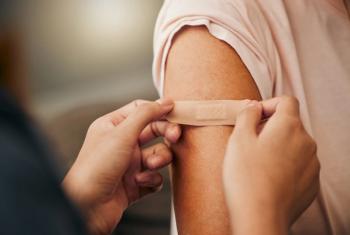
Alice Hoyt, MD, discusses the importance of quick epinephrine use for anaphylaxis
Alice Hoyt, MD, FAAAI, discussed the Early Childhood Anaphylaxis Collaborative’s efforts to improve anaphylaxis preparedness in early childcare settings.
A multidisciplinary initiative is aiming to enhance anaphylaxis preparedness across early childcare settings. The Early Childhood Anaphylaxis Collaborative—made up of multiple advocacy and professional organizations—brings together experts, clinicians, educators, and parents to strengthen awareness and emergency response for severe allergic reactions in young children. The effort includes Alice Hoyt, MD, FAAAI, Board-certified allergist and immunologist; Chief allergist, Hoyt Institute of Food Allergy; Chair, Code Ana; Founding partner, Early Childhood Anaphylaxis Collaborative, who spoke with Contemporary Pediatrics about the Collaborative’s goals and evolving best practices in pediatric anaphylaxis care. Hoyt emphasized that the Collaborative’s impact comes from unifying mission-driven groups to support families and childcare providers.1
“It brings together multiple organizations…to really help ensure that when parents send their children to early child-care centers at their youngest ages…that these centers are prepared to prevent, but also recognize and respond to an anaphylaxis emergency,” she said. “It really amplifies the message, which is: we can be prepared, and we can prevent these anaphylactic tragedies, honestly.”
The Early Childhood Anaphylaxis Collaborative
The following make up the founding partners of the Collaborative:
- Association for Early Learning Leaders
- Asthma and Allergy Foundation of America
- Code Ana
- Elijah-Alavi Foundation
- Food Allergy & Anaphylaxis Connection Team
- Kaléo
- Kids with Food Allergies
WATCH MORE: Chapter 1: When to Use Epinephrine in Anaphylaxis
Food allergies remain the leading cause of anaphylaxis in children, Hoyt noted, underscoring the importance of early recognition and immediate intervention. She highlighted outdated practices that prioritized antihistamines, stating, “The right approach is: as soon as anaphylaxis is recognized, you promptly use epinephrine.”
Hoyt also explained why epinephrine must be first-line therapy: “These devices are made to be user-friendly, and they provide the right amount of epinephrine — and epinephrine that a child needs.” She added that antihistamines cannot stop the underlying cellular cascade: “That’s why it’s so important that we promptly use epinephrine as soon as anaphylaxis is recognized.”
Advancements in anaphylaxis treatment
In August of 2024, the FDA approved epinephrine nasal spray (neffy), with an expanded indication approved in
The approval has been celebrated across the allergy and immunology community as another option to treat type I allergic reactions, including anaphylaxis, one that is needle-free.
In September, neffy's developer ARS Pharmaceuticals, announced real-world data supporting the effectiveness of the needle-free epinephrine. In the analysis, 545 patients who experienced anaphylaxis symptoms during oral food challenge or immunotherapy were treated with neffy by a health care provider.4
In all, 89.2% of patients treated with the epinephrine spray achieved symptom resolution with a single dose. This success rate mirrors findings from meta-analyses of epinephrine intramuscular injection or auto-injector, which report single-dose effectiveness in 88.9% of patients treated for food-induced anaphylaxis, according to ARS.
With additional tools available, Hoyt stressed the importance of quick action.
"The most important thing is as soon as [you recognize] that it is anaphylaxis, you're treating it promptly with epinephrine."
References:
- National organizations unite to prepare early childhood facilities for rising incidence of food allergies. Kaléo. Press release. April 23, 2025. Accessed November 19, 2025. https://www.globenewswire.com/news-release/2025/04/23/3066351/0/en/NATIONAL-ORGANIZATIONS-UNITE-TO-PREPARE-EARLY-CHILDCARE-FACILITIES-FOR-RISING-INCIDENCE-OF-FOOD-ALLERGIES.html
- Fitch J. FDA approves neffy as first nasal spray to treat anaphylaxis. Contemporary Pediatrics. Published August 9, 2024. Accessed November 19, 2025. https://www.contemporarypediatrics.com/view/fda-approves-neffy-as-first-nasal-spray-to-treat-anaphylaxis
- Fitch J. FDA approves neffy 1 mg for anaphylaxis in children aged 4 years and older. Contemporary Pediatrics. Published March 6, 2025. Accessed November 19, 2025. https://www.contemporarypediatrics.com/view/fda-approves-neffy-for-anaphylaxis-in-children-aged-4-years-and-older
- Fitch J. Neffy demonstrates positive, real-world data for anaphylaxis. Contemporary Pediatrics. Published September 9, 2025. Accessed November 19, 2025. https://www.contemporarypediatrics.com/view/neffy-demonstrates-positive-real-world-data-for-anaphylaxis
Newsletter
Access practical, evidence-based guidance to support better care for our youngest patients. Join our email list for the latest clinical updates.










